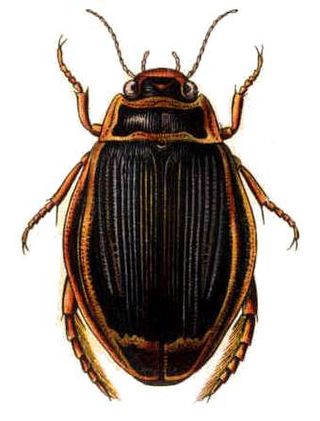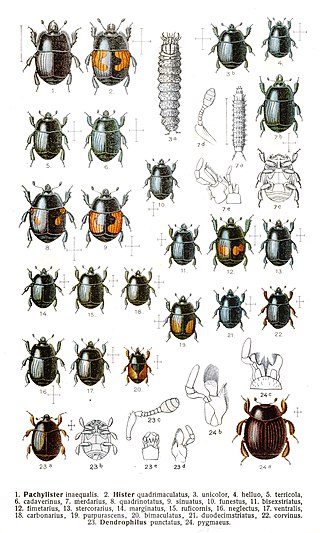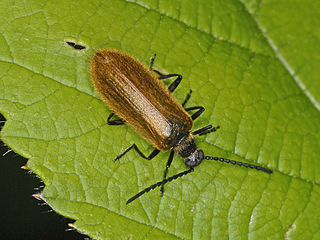
Beetles are insects that form the order Coleoptera, in the superorder Holometabola. Their front pair of wings are hardened into wing-cases, elytra, distinguishing them from most other insects. The Coleoptera, with about 400,000 described species, is the largest of all orders, constituting almost 40% of described insects and 25% of all known animal species; new species are discovered frequently, with estimates suggesting that there are between 0.9 and 2.1 million total species. Found in almost every habitat except the sea and the polar regions, they interact with their ecosystems in several ways: beetles often feed on plants and fungi, break down animal and plant debris, and eat other invertebrates. Some species are serious agricultural pests, such as the Colorado potato beetle, while others such as Coccinellidae eat aphids, scale insects, thrips, and other plant-sucking insects that damage crops.

The Haliplidae are a family of water beetles that swim using an alternating motion of the legs. They are therefore clumsy in water, and prefer to get around by crawling. The family consists of about 200 species in 5 genera, distributed wherever there is freshwater habitat; it is the only extant member of superfamily Haliploidea. They are also known as crawling water beetles or haliplids.

Dytiscus is a Holarctic genus of predaceous diving beetles that usually live in wetlands and ponds. There are 26 species in this genus distributed in Europe, Asia, North Africa and North and Central America. They are predators that can reduce mosquito larvae.

The great diving beetle is an aquatic diving beetle native to Europe and northern Asia, and in the UK is common in Wales, much of England and southern Scotland but less common on chalk and in the far north. The great diving beetle, true to its name, is a rather large insect. The larvae can grow up to 60 millimetres (2.4 in) in length, while the adults are generally 27–35 millimetres (1.1–1.4 in).

The Dytiscidae – based on the Greek dytikos (δυτικός), "able to dive" – are the predaceous diving beetles, a family of water beetles. They occur in virtually any freshwater habitat around the world, but a few species live among leaf litter. The adults of most are between 1 and 2.5 cm (0.4–1.0 in) long, though much variation is seen between species. The European Dytiscus latissimus and Brazilian Megadytes ducalis are the largest, reaching up to 4.5 cm (1.8 in) and 4.75 cm (1.9 in) respectively. In contrast, the smallest is likely the Australian Limbodessus atypicali of subterranean waters, which only is about 0.9 mm (0.035 in) long. Most are dark brown, blackish, or dark olive in color with golden highlights in some subfamilies. The larvae are commonly known as water tigers due to their voracious appetite. They have short, but sharp mandibles and immediately upon biting, they deliver digestive enzymes into prey to suck their liquefied remains. The family includes more than 4,000 described species in numerous genera.

Histeridae is a family of beetles commonly known as clown beetles or hister beetles. This very diverse group of beetles contains 3,900 species found worldwide. They can be easily identified by their shortened elytra that leaves two of the seven tergites exposed, and their geniculate (elbowed) antennae with clubbed ends. These predatory feeders are most active at night and will fake death if they feel threatened. This family of beetles will occupy almost any kind of niche throughout the world. Hister beetles have proved useful during forensic investigations to help in time of death estimation. Also, certain species are used in the control of livestock pests that infest dung and to control houseflies. Because they are predacious and will even eat other hister beetles, they must be isolated when collected.

Dytiscus latissimus is a large species of aquatic beetle in family Dytiscidae. It is native to Europe and considered threatened.

Oiceoptoma noveboracense is a member of the family Silphidae, or carrion beetles, which feed on decaying organic matter such as dead animals. Its common name is the margined carrion beetle, from the orange-red margins on the pronotum, which are helpful when identifying this species. The larva is typically light brown to red and also has vertical ridges on its thorax like the adult. This diurnal beetle can be found mainly in the spring into the fall, and it has a strong preference towards a deciduous forest habitat. The primary forensic importance of this beetle is its ability to use the succession of insect fauna to provide confirmation of postmortem intervals.

Acilius sulcatus is a species of water beetle in the family Dytiscidae. It is fairly large, with color variation shown throughout its range. Typically it is yellow and black.

Chrysomela populi is a species of broad-shouldered leaf beetle belonging to the family Chrysomelidae, subfamily Chrysomelinae.

Polydrusus formosus the green immigrant leaf weevil, is a species of broad-nosed weevil belonging to the family Curculionidae, subfamily Entiminae.

Anoplotrupes stercorosus, the dor beetle, is a species of earth-boring dung beetle belonging to the family Geotrupidae, subfamily Geotrupinae.

Hydrophilus acuminatus, common name dark diving beetle, is a species of water scavenger beetles belonging to the family Hydrophilidae.

Lagria hirta is a species of beetles in the family Tenebrionidae.

Zabrus tenebrioides is a species of black coloured ground beetle in the Pterostichinae subfamily that can be found everywhere in Europe and the Near East.

Apoderus coryli, common name hazel-leaf roller weevil, is a species of leaf-rolling beetles belonging to the family Attelabidae subfamily Attelabinae. Because of the trunk-like elongated head, it is often mistakenly attributed to the weevils.

Cionus hortulanus is a species of weevils belonging to the family Curculionidae, subfamily Curculioninae.
Luciola substriata is a species of firefly found in India, Myanmar, China and Taiwan. The larvae are aquatic and can swim, living in marshes, paddies, lakes and ponds.

Hydaticus pacificus, is a species of predaceous diving beetle found in South and South East Asia.

Rhantus suturalis, commonly known as the supertramp beetle or cosmopolitan diving beetle, is a species of diving beetle (Dytiscidae) with a cosmopolitan distribution.



















